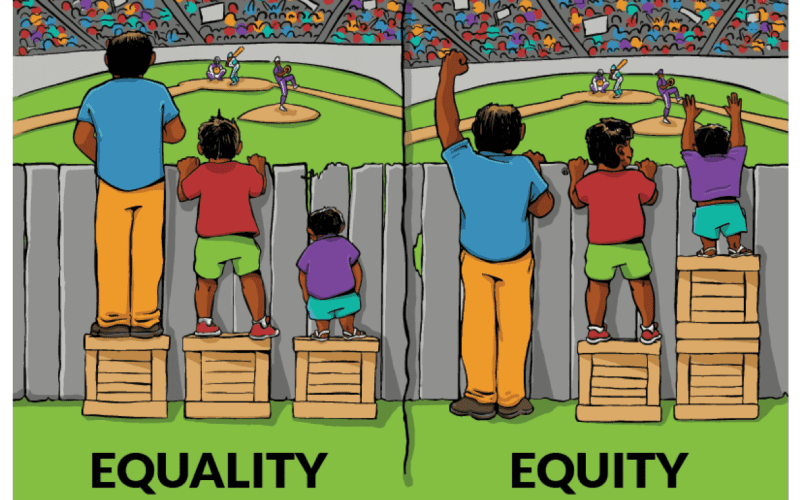Introduction:
Imagine two students. Alex, a high school junior brimming with curiosity, sits in his under-resourced classroom. Cracked screens flicker on outdated laptops, and the Wi-Fi sputters, barely clinging to life. Frustration clouds his brow as he tries to access an online learning resource, only to be met with an error message. Meanwhile, across town, Sarah navigates a vibrant digital learning environment. Personalized software adapts to her needs, offering interactive simulations and engaging multimedia content. Seamless internet connectivity fuels her exploration, and a diverse range of online resources are readily available at her fingertips. This stark contrast, a reality for countless students, sparks a crucial question: Is education technology (EdTech), lauded as a gateway to opportunity, inadvertently widening the chasm of educational inequality?
The Promise and Peril of Education Technology

Education technology holds immense potential. It promises personalized learning, improved engagement. And access to a wealth of information, and enhanced collaboration. Dr. Maria Garcia also leading researcher in educational technology and social justice and warns in her recent report.The Double-Edged Sword the Education Technology and Equity Concerns. That the digital divide can exacerbate existing inequalities, leaving disadvantaged students further behind. The report delves into the complex interplay between EdTech and equity, highlighting areas where technology, if not implemented thoughtfully, can perpetuate disparities.
Access to Education Technology
The most glaring concern is the persistent digital divide. Not all students have equal access to devices.But reliable internet connectivity and the technical skills needed to navigate the complex digital landscape. This lack of access translates to missed opportunities, limited participation in online learning activities, and ultimately, academic disadvantage.
Algorithms and Education Technology

Beyond access lies the issue of hidden biases embedded within algorithms. From biased content recommendations to inaccurate assessments, algorithms can amplify existing inequalities and perpetuate discriminatory learning experiences. For instance, an algorithm trained on data skewed towards certain demographics might misclassify students from marginalized communities, leading to inaccurate placements or limited access to advanced resources.
Human Element and Education Technology
Technology is a tool, but its effectiveness hinges on the human element. Without proper teacher training and support, EdTech risks exacerbating existing pedagogical inequities. Teachers need training in integrating technology equitably. And fostering inclusive online learning environments, and mitigating algorithmic bias.
Privacy Concerns and Education Technology
As data collection becomes increasingly intertwined with EdTech, student privacy becomes a paramount concern. The potential for surveillance misuse of personal information. And lack of transparency can create a chilling effect on student participation and expression.
Discrimination and Education Technology

Dr. Garcia emphasizes that equity concerns go beyond mere access. It’s not just about providing devices. She stresses but about ensuring fair and inclusive learning experiences for all students. This requires addressing the deeper issues of algorithmic bias, teacher training, and student privacy.
The Human Element:
Teachers play a crucial role in bridging the equity gap. Equipping them with the skills and training to use technology effectively is paramount. This includes:
- Culturally responsive pedagogy: Educators should be trained to incorporate diverse perspectives and avoid culturally insensitive content.
- Critical thinking skills: Students need to be equipped to critically evaluate online information and identify potential biases.
- Data literacy: Educators and students alike should understand how data is collected, used, and protected.
Empowering Voices:

Students are not passive recipients of education. They are active participants who deserve a voice in shaping their learning environments. Empowering students to advocate for their needs, question algorithmic bias. And contribute to shaping data governance policies is crucial for achieving true equity.
Charting a Path Forward:
Dr. Garcia offers a roadmap for a more equitable future of EdTech:
- Investing in infrastructure: Bridging the digital divide requires investments in broadband infrastructure, device subsidies, and school-based access programs.
- Developing diverse data sets: Algorithms should be trained on diverse data sets to mitigate bias and reflect the richness of the student population.
- Transparency and accountability: Clear data privacy policies, student involvement in data governance, and independent oversight are essential for ensuring responsible data use.
- Collaborative partnerships: Collaboration between educators, researchers, policymakers, and community stakeholders is crucial for developing and implementing equitable EdTech solutions.
Conclusion:
Education technology is a powerful tool, but its potential can be harnessed for good or harm. Recognizing the equity concerns associated with EdTech and actively working towards solutions is crucial for ensuring that technology empowers all students, not simply widens the existing gap. By investing in infrastructure, addressing algorithmic bias, fostering inclusive learning environments, and empowering student voices, we can chart a path towards a future where technology unlocks the potential of every learner












